|
FAQs about Limpet Snails, Acmaeidae,
Fissurellidae and more, Scutus, Stomatella
3
Related Articles: Gastropods, Sea Slugs, Mollusks, Abalone,
Related FAQs:
Limpets 1, Limpets 2, Limpets 4, & Limpet Identification 1, Limpet ID 2, Limpet
Behavior, Limpet Compatibility,
Limpet Selection, Limpet Systems, Limpet Feeding, Limpet Disease, Limpet Reproduction, & Marine Snails 1, Marine Snails 2, Marine Snails 3, Marine Snails 4, Snail ID 1, Snail
ID 2, Snail Behavior, Snail Selection, Snail Compatibility, Snail Systems, Snail Feeding, Snail Disease, Snail Reproduction, Mollusks, Sea
Slugs, Abalone,
|
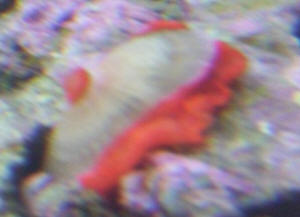
|
|
Limpet 4/18/14
<... nine Megs... what is our requirement and why?>
So I've found quite a few of them in my tank. Was wondering if you guys
could tell me which kind exactly this is and if I should be concerned.
I've seen that keyholes are coral eaters; can't have that. Thank you in
advance!!
<Just read here:
http://wetwebmedia.com/LimpetID2.htm
and the linked files above. Bob Fenner>
Genevieve Badough
|
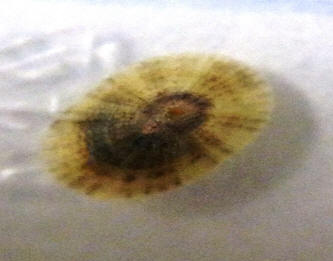 |
Re: Aiptasia in curing live rock for invertebrate-only tank,
Limpet avail. 10/2/11
Bob - Thank you! I'll wait for cycling to complete and then put in
peppermints, hermits, and Nudibranchs if I can get them. I'm glad
you said to wait for curing to complete. That's what I wanted to
hear!
<Ah good>
By the way, I've been researching limpets here, and I noticed
several people asking where to get them. I purchased some from
reefcleaners.org and was very happy with their quality and
service.
<Thank you for this input>
My new limpets are leaving scorched earth in their path, but I guess
that's the point. Just thought I'd pass along that source in
case anyone else asks.
Tim
<Cheers, BobF>
|
Cap Snail ID: Batman is a Scutus! 4/5/10
<Hi Chris, Lynn here today.>
I have a cap snail in my tank that has doubled in size since
first noticing it about 4 months ago.
<That's a happy snail!>
It has been a joy watching it cruise the tank. We call him
"Batman".
<Heeee! Love the name!>
My question is "Can you identify it from the attached photo
and if so, how big will it get?"
<I sure can. 'Batman' is a species of Scutus, aka a
Ducksbill Limpet, Elephant Slug, etc., in the Family
Fissurellidae (Keyhole and Slit Limpets). They're mostly
algal grazers but apparently some do eat sponges. All in all,
they're beneficial/welcome additions to a reef system.
Regarding size, it depends on the species, but most have the
potential to get up to around 2' in length. There's a
species from Australia and New Zealand though (Scutus antipodes),
that can reach 5' in length. Now that's a big snail! For
more information, please see the following link:
http://www.seaslugforum.net/factsheet.cfm?base=scutus >
Thanks in advance,
<You're very welcome, enjoy Batman!>
Chris
<Take care, LynnZ>
|
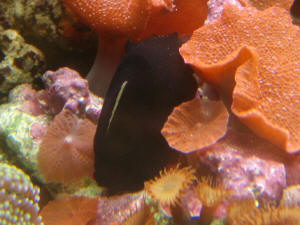 |
|
10/02/10 Dead Chitons.. No, Limpets!
Hi Simon,
<Hello Beth, how are you?>
My aquariums are doing fine at the moment, thanks to you.
<That's great news!>
Still having a few minor problems with alkalinity and calcium but
I am giving it one more water change before I try to address that
problem, again.
<Ok. Keep referring to the chemist-man RHF and you should make
it through!>
Right now, I am finding dead Chitons in the 20g tank. My big 1
1/2" Chiton is now just an empty shell and this past Sunday
I found another Chiton clinging to a rock with what looked like a
mucus net surrounding it.
<These are Limpets, not Chitons. They have a conical shell and
some have a hole on the top. Chitons are segmented.>
Could the mucus be a defensive mechanism of the Chiton or is it
what killed the Chiton?
<This has probably come from the Limpet itself when it died.
Did you not think you had a predator of these somewhere?>
It was Super Bowl Sunday and I promised my dad I would watch it
with him so I snapped a couple of pictures and ran out the door.
When I came home the next day, I found the empty shell of the
Chiton lying in the sand.
Any clue as to what is happening to the Chitons?
<I'm sorry Beth, apart from a predator and/ or water
chemistry I have no idea. Remember that these need balanced
calcium & alkalinity to build their shells. If these have
been 'off' for some time, on top of the other
problems that you have had, then that could easily explain their
deaths.
Maybe it has all just been 'too much'. Do be sure to test
to make sure that you do not end up with a 'cascade'
effect that affects your other creatures>
Thank You for your help,
<No problem at all>
Beth
<Simon>
|
 |
|
Help Me Identify This Snail: Stomatellid --
1/26/10
<Hello Nick, Lynn here today.>
I discovered this little guy crawling around the back corner of
my tank last night.
<Neat>
Any ideas on what it is and where it came from.
<It's a pretty little Stomatellid (probably Stomatella
varia) that most likely originated in the Western Pacific.
They're common, harmless/beneficial herbivorous grazers in
the family Trochidae. For more information, please see the
following links:
http://bb.wetwebmedia.com/viewtopic.php?f=25&t=181
Be sure to Google WWM for a veritable boatload of FAQ's re:
http://www.wetwebmedia.com/Googlesearch.htm
Photos of Stomatella varia:
http://www.gastropods.com/2/Shell_2422.shtml >
I had never seen it before. Thanks for all the info and service
you all provide.
<You're very welcome and thank you!>
Nick
<Take care, LynnZ>
|
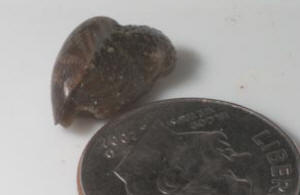 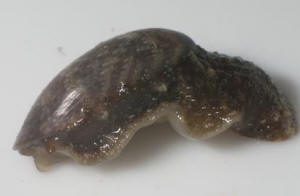 |
Help with identifying unknown snail?? Invert., SW...
1/25/10
<Hello Blaire, Lynn here today.>
I've had my aquarium for about 6 months now. About 2 months ago I
bought some live rock from someone who was parting out their tank.
Needless to say I brought in all sorts of new life forms.
<Neat>
There were a bunch of tiny pretty snails, pods, bristleworms, even some
neat looking mini anemones I couldn't identify that my Klein's
has since ate. (They weren't Aiptasia). There's one thing I
can't seem to identify though. It's about 3/4", slightly
more oblong than round, and very dark blue in color. If the light
isn't directly on it, it looks black. It does not have an actual
hard shell, and I can only say "snail" because it has a
snail's head with antennas. The "shell" is soft and
flexible (like the body of a ray), and it is very slow moving. I
can't really get a pic of it as I only see it a couple times a week
and it's always between rocks, never out in the open. Any help you
can give me would be greatly appreciated!
<Hmmm, there are many possibilities. An animal with antennae but no
visible shell could be some sort of sea slug, Nudibranch, Polyclad
flatworm, or even a Scutus unguis (aka the 'Ducksbill Limpet').
Soft and ray-like sounds more like a flatworm or some sort of slug or
Nudibranch, rather than a Scutus spp. but it's worth looking into.
Scutus unguis actually has a white shell, but it's usually covered
by the animal's deep black mantle. It's possible that under
certain lighting, the flexible black mantle could appear bluish.
I'm sorry I can't be more helpful but there are just too many
possibilities. Here are some links that will hopefully help narrow
things down a bit.
Nudibranchs: http://www.wetwebmedia.com/nudibran.htm
Sea Slugs: http://www.wetwebmedia.com/seaslugsopisthobranchs.htm
Polyclad Flatworms (see Pseudoceros sapphrinus):
http://www.wetwebmedia.com/WormPIX/FlatwormPIX/Flatworms2.htm
Scutus Unguis: http://www.seaslugforum.net/showall/scutus
Please let me know if you need any additional help. I know a picture
sounds impossible, but if you get lucky, send it along!>
Thank you, Blaire
<You're very welcome. Take care, LynnZ>
Re: Help with identifying unknown snail?? Scutus Unguis -
1/25/10
Hi Lynn,
<Hi Blaire.>
Thank you so much for your help!
<You're welcome!>
I looked it up and it's a Duckbill Limpet.
<Neat little creatures.>
All the little life forms that pop up are such treasures and I make it
a
point to find out what they are and what their needs are. Maybe you
could answer one more question for me? I have a Harlequin shrimp (what
a beauty!) and would like to know if there is anything I could add to
my tank that would dispose of the leftovers of the starfish he eats?
I've asked my LFS guys and they say my clean up crew should take
care of it but they don't. These little white pieces are adding up
quick and I can't get to them to siphon them out. Any
suggestions??
<If you don't already have hermits, I'd recommend getting
some Nassarius snails. They're terrific little scavengers that stay
hidden within the substrate then erupt en mass when they smell food.
They also have the added advantage of stirring the sand up a bit as
they move around. You could try either Nassarius vibex, a small species
(usually less than 1/2") or the larger (up to ~1') Nassarius
distortus, frequently called 'Super Tongan' Nassarius snails.
Both are commonly available on the 'net and elsewhere. Avoid any
snail sold as Nassarius obsoleta. It's actually Ilyanassa obsoleta,
a smallish brown snail that comes from cooler waters and lives
accelerated/shortened lives in the higher temperatures of our reef
systems. Another possibility, if you already have hermits (and you like
them), is to add a few more. I'm not a big fan because of their
tendency to pick at beneficial sessile livestock/fauna, rob corals of
food and occasionally kill snails but it's up to you. It just
depends on what you want to keep. Please see the following links for
photos of the various Nassarius species, as well as the Ilyanassa
obsoleta snail that you'll want to avoid!
Nassarius vibex: http://www.gastropods.com/0/Shell_1930.shtml
Nassarius distortus: http://www.gastropods.com/9/Shell_3309.shtml
Ilyanassa obsoleta: http://www.gastropods.com/5/Shell_3305.shtml >
Thanks again, Blaire
<It was a pleasure. Take care, LynnZ>
|
Mollusk ID: It's The Incredible Mr. Limpet! --
1/21/10
Hi.
<Hello Beth, Lynn here today.>
I was wondering if you could help me figure out what this is.
<Fire away>
I have a 29 g tank that has been running for about 4 years. While
I was doing a water change, I noticed this little guy on a conch
shell (by the way my gold striped clown insists that the conch is
his anemone).
<That's a clown for you!>
I was hoping you could tell me what this is.
<It's a pretty little Keyhole Limpet, family
Fissurellidae. There are other similarly shaped Mollusks, but the
hole at the apex/top is the clincher. This opening, which is used
for expelling waste, can vary from round to distinctly keyhole
shaped, hence the name. Also typical is the arrangement of
concentric growth rings (often showing as different colors),
along with the strong radiating ribs/ridges that extend from the
shell's top/opening to the bottom edge. The almost rough
surface can sometimes be obscured by a growth of algae (usually
green or coralline), but doesn't harm the animal. The
feathery-looking protrusions you see on the soft tissue mantle
skirting the shell are called 'mantle tentacles', and are
sensory in nature. These neat little creatures are for the most
part harmless/beneficial herbivorous grazers but if the food
supply runs low, they can occasionally move on to soft corals or
large polyped stony corals. For example, I had Keyhole Limpets
for years in my tanks with no problems until one large individual
decided to munch on my favorite cherry red Blastomussa wellsi
polyps -- aaahh! Needless to say, he was ejected from the
display! That's the one and only problem I've ever had
with Keyhole Limpets. Personally, I'd leave your little
individual in place and enjoy it. For more information, please
see the many WWM FAQ's regarding. Just Google the term
Keyhole Limpet: http://www.wetwebmedia.com/Googlesearch.htm
Thanks so much for you help,
<You're very welcome. Enjoy Mr. Limpet!>
Beth Van Zandt
<Take care, LynnZ>
|
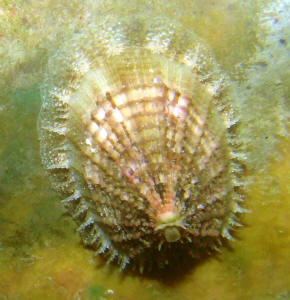 |
|
Baby snails...or something else? Probably something
else. 1-17-10
I've noticed these little snails in my tank a few months ago.
They were very small, just a tiny white dot. Now that they got to
an acceptable size I want to know if you could help me identify
them. <I can try!> I have a few Astrea snails in my tank
and Nassarius Tonga and Vibex. These little snails spend all
their time on the glass and don't hide during the day. What
worries me is that it started with 3 and now I have at least 25.
They dont seem to be bothering anything but I want to make sure
they are safe. I included a pic I hope it is clear enough.
<Unfortunately, no.> The biggest one I noticed the other
day is probably 1/4 inch. Hope you can help. Thank you very
much.( I read all the articles but could not find any positive
ID). <I'm assuming your attached photo shows the underside
of the animal attached to the glass. It doesn't look to be a
snail at all. My best guess points to most likely a Chiton, or
possibly a limpet. I can't give much other specifics without
a better photo. Maybe Bob can chime in with his
$.02.><<Do look like Limpets to me as well.
RMF>>
Brion
<Matthew>
|
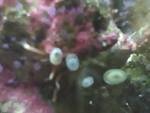 Full size pic Full size pic |
|
Re Baby snails...or something else?
Probably something else. 1/18/10
Thanks I know you tried your best. <You're very welcome.
If you want to send another photo of the critters in question, we
might be able to help out a bit more.> We took one out of the
tank to examine it better. It has a
hard cone shaped shell, some shells are black and some are tan.
The shell looks a little like a limpet like you said. <Limpets
are highly variable in nature. That's the best I could come
up with.> They have the 2 antennas that snails have and I can
see their mouths grazing the glass just like my Astrea snails.
Are all these common features of the limpets as well?
<Limpets do have antennae. I don't know too much about
them other than what they look like, unfortunately. Based on your
mouth and antenna description baby Stomatella snails are another
possibility. Do enquire via
a Google image search.> Sorry I couldn't get a better
picture. <Try, try again. Even out of the water might be
insightful.> Thanks at least I know they are safe and wont
harm anything. <Welcome. Matthew.>
|
|
Hoof limpet - 11/07/09
Hello,
I have attached a picture of what I believe to be Hipponicidae
sp. residing on the back of one of my snails!
<Looks like it!>
I have 'Googled' around and found some supporting
information but wondered whether this was a true example of
symbiosis
<Mmm, of a sort... I'd label this animal as a "space
parasite"... as the "host" appears to be harmed to
a degree, and definitely doesn't seem to benefit from the
Limpet>
or just an accident. The forked proboscis (if that's the
right term) extends significantly from the shell during feeding
as it picks around the areas that the snail is grazing so I
assume is diet is basically the same.
I not been able to narrow down to species level but suspect that
it is a harmless hitchhiker as the 'host' seems to be
unaffected.
<Mmm... I don't know... having something so large, heavy
on ones shell...>
I found it interesting and have not seen any similar pictures on
the web so wondered whether you would be interested too.
<Yes. Thank you for sharing>
Forgive my ignorance if it is actually common and I'm just
bad at web searches but if it is unusual I can think of no better
place to share it.
Your site has helped me a great deal over the years and continues
to be my favourite reference as the reliability and accuracy of
information here is in my humble opinion, above question.
Many Thanks,
Chris
<Welcome Chris! Bob Fenner>
|
 |
|
Yellow Mobile Unknown Hitchhiker 9/10/09
Hello,
<Howsit?>
I have a very colorful hitchhiker that showed up about 3 months
ago. It was smaller than a pencil eraser at that time but over
the months it has grown to about the size of a quarter. It does
move around on the rocks,
not very fast but fast enough to make me look for him every
morning and evening. He is circular and mostly flat, except in
the center. Looks to be a mouth but I'm just guessing at
that. I took a photo this evening and
as I was focusing, it spit out a white speck from the
"supposed" mouth.
Is this something beneficial or is it harmful to my reef
aquarium.
<More the former... I think this is the Limpet Lucapina aegis.
Bob Fenner>
Thank You
Beth
|
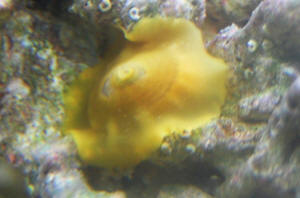 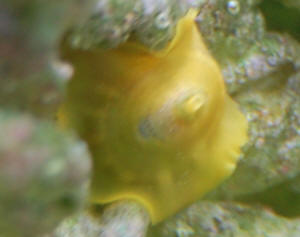 |
Re: Yellow Mobile Unknown Hitchhiker 9/10/09
Hello Again,
<Waking up now!>
After months of looking for the name of this hitchhiker, I
finally ask for assistance in identification and of course, in
the meantime, I keep looking for the answer. I used a different
search engine and different key words and I think that I found
the id. Is the answer Keyhole Limpet?
Thank You,
Beth
<A different Limpet (Thrummmm!). BobF>
Re: Yellow Mobile Unknown Hitchhiker
9/10/09
Morning Bob,
<And you Beth>
Grab a cup of coffee and wake up.
<Am trying>
Just got your note, I am assuming the "different
limpet" means that I have the wrong species?,
<Mmm, yes... but such are the dangers of common
appellations>
I was going to go with Fleshy Limpet but the information I found
states that these are Keyhole Limpets as well.
<"You say tomatoe"... Megathura is the genus of our
(Calif.) Keyhole...>
However, the information also states that they are about the size
of a shield limpet or smaller. I have a shield limpet and my
yellow limpet is much bigger than the shield limpet.
Of course you could be stating that it is just a unusual looking
limpet.
In which case, I totally agree.
I am getting conflicting information about limpets and cannot
decide if they are beneficial or harmful. Do you have any
thoughts about the benefits or harm that they can cause to coral
and or live rock?
Thanks Again,
<... Please read on WWM re such Archaeogastropods....
BobF>
Re: Yellow Mobile Unknown Hitchhiker
9/10/09
Morning Bob,
<Still?>
Please ignore last post. I read your response to my second post
and did not see your answer to my original inquiry until a few
minutes ago. Yahoo sent it to my Spam folder.
Thanks
Beth
<Velkommen! B>
|
Incredible Mr. Limpet Multiplying 7/13/09
Hello all.
<Thrummmm!>
I would like to start by saying you have a great site. I've found
most of my answers to my seemingly endless dumb questions here.
And on with the show... A little background info, my sister had a ten
gal. tank for about 1 year. In this tank she had a fuzzy dwarf
lion,
<Mmm, crowded...>
a few blue legs, button polyps, mushrooms, live rock, and ONE quarter
sized limpet. She gave the tank to me roughly 10 months ago. About 2
months ago the limpet died from an unknown cause.
<"Variable water quality" likely>
About 3 weeks ago I noticed 15 tiny (1/8 inch) limpets roaming
around.
Nothing has been added to the tank in the last 14 months. So here is
the questions. Can limpets reproduce asexually?
<Mmm, not as far as I'm aware. They release eggs or sperm into
the water column, cued environmentally...>
Have they been in there the whole time unnoticed?
<Possibly...>
All of my research says they reproduce sexually (w/eggs and sperm)
around stormy times of the year, but I only had ONE. Since I first
noticed them 3 have almost doubled in size, so I have a hard time
believing they've always been there unnoticed.
Thanks in advance,
Derek from Holiday, Florida
<Thank you for sharing Derek. Bob Fenner>
Stomatella varia, sel./source 04/02/09
I've spent a hours searching the web for a place to purchase
Stomatella Varia. So far I've come up with very little and nothing
reliable. I've spoken to people at my LFS's and they are
keeping an eye out for me as
they do their water changes. However, in my searching I've found
numerous others on many forums stating that they wish they could find a
place to buy these.
So my question is 2 fold:
1) Are there places online where these snails can be purchased online
w/o buying a whole 'refugium kit'?
<Yes, please see here:
http://www.inlandaquatics.com/prod/tr_invert.html>
2) Why are they so hard to find?
<Good question! They are definitely some of my faves.>
The only suggestion on how to get them that I've seen is "buy
live rock..you'll likely get some". But with so many looking
in vain I can't help but wonder why no one seems to sell them.
Thanks!
<Do please contact Morgan L. of Inland Aquatics. I have bought these
snails from him many times and they always arrived healthy.
Cheers,
Sara M.>
|
Keyhole Limpet: Lucapina sp. --
1/17/09
<Hello there!>
I am trying to identify this keyhole limpet. It came from Florida
with an order from critters.
<Neat>
I can't find this particular one in any pictures.
<It appears to be what's commonly called a fleshy limpet,
in the genus Lucapina (possibly Lucapina suffusa). Please see the
photos at the following link for comparison:
http://z14.invisionfree.com/Conchologist_Forum/index.php?s=3d4adb02ec7886bb7914cf50fad8f838&showtopic=984&st=0&#last
I wanted to see if it is one of the bad ones.
<Fleshy limpets are not usually a problem in captive reef
systems. I'd leave it in place and enjoy! For more
information, please see the 'Limpets' section at the
following link. The last paragraph specifically relates to
Lucapina species.
http://reefkeeping.com/issues/2004-06/rs/index.php
>
Any help would be greatly appreciated.
<You're very welcome. Looks like you've got a gorgeous
little limpet! Take care, Lynn>
|
 |
|
|

